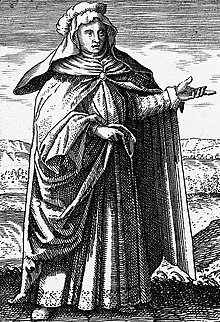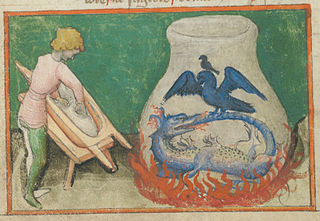
Alchemy is an ancient branch of natural philosophy, a philosophical and protoscientific tradition that was historically practised in China, India, the Muslim world, and Europe. In its Western form, alchemy is first attested in a number of pseudepigraphical texts written in Greco-Roman Egypt during the first few centuries AD.

Abū Mūsā Jābir ibn Ḥayyān, died c. 806−816, is the purported author of an enormous number and variety of works in Arabic, often called the Jabirian corpus. The works that survive today mainly deal with alchemy and chemistry, magic, and Shi'ite religious philosophy. However, the original scope of the corpus was vast and diverse, covering a wide range of topics ranging from cosmology, astronomy and astrology, over medicine, pharmacology, zoology and botany, to metaphysics, logic, and grammar.
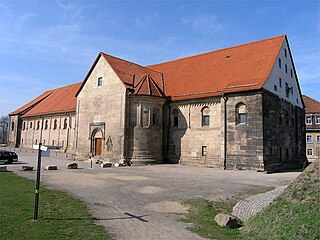
Basil Valentine is the Anglicised version of the name Basilius Valentinus, ostensibly a 15th-century alchemist, possibly Canon of the Benedictine Priory of Saint Peter in Erfurt, Germany but more likely a pseudonym used by one or several 16th-century German authors.
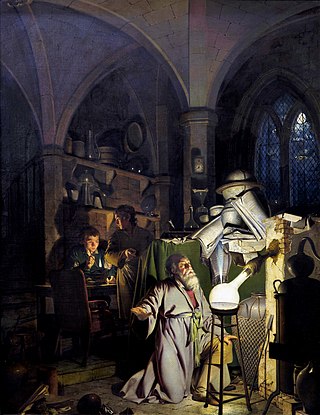
The philosopher's stone is a mythic alchemical substance capable of turning base metals such as mercury into gold or silver. It is also called the elixir of life, useful for rejuvenation and for achieving immortality; for many centuries, it was the most sought-after goal in alchemy. The philosopher's stone was the central symbol of the mystical terminology of alchemy, symbolizing perfection at its finest, divine illumination, and heavenly bliss. Efforts to discover the philosopher's stone were known as the Magnum Opus.

Nicolas Flamel was a French scribe and manuscript seller. After his death, Flamel developed a reputation as an alchemist believed to have created and discovered the philosopher's stone and to have thereby achieved immortality. These legendary accounts first appeared in the 17th century.

In Renaissance alchemy, alkahest was the theorized "universal solvent". It was supposed to be capable of dissolving any other substance, including gold, without altering or destroying its fundamental components. By reducing or dissolving substances into their fundamental virtues and properties, it was hoped to gain control of those invaluable medical healing properties, and for this reason the alkahest was earnestly sought, and the reality of its existence was debated among the alchemists and philosophers.

Vitriol is the general chemical name encompassing a class of chemical compounds comprising sulfates of certain metals – originally, iron or copper. Those mineral substances were distinguished by their color, such as green vitriol for hydrated iron(II) sulfate and blue vitriol for hydrated copper(II) sulfate.
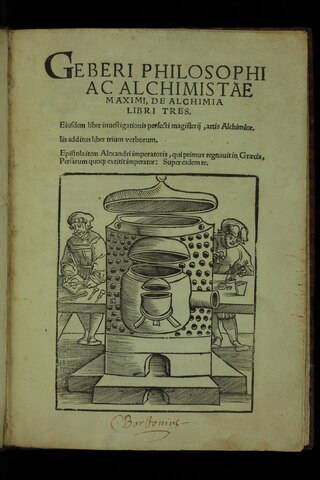
Pseudo-Geber is the presumed author or group of authors responsible for a corpus of pseudepigraphic alchemical writings dating to the late 13th and early 14th centuries. These writings were falsely attributed to Jabir ibn Hayyan, an early alchemist of the Islamic Golden Age.

The Emerald Tablet, also known as the Smaragdine Tablet or the Tabula Smaragdina, is a compact and cryptic Hermetic text. It was highly regarded by Islamic and European alchemists as the foundation of their art. Though attributed to the legendary Hellenistic figure Hermes Trismegistus, the text of the Emerald Tablet first appears in a number of early medieval Arabic sources, the oldest of which dates to the late eighth or early ninth century. It was translated into Latin several times in the twelfth and thirteenth centuries. Numerous interpretations and commentaries followed.

Projection was the ultimate goal of Western alchemy. Once the philosopher's stone or powder of projection had been created, the process of projection would be used to transmute a lesser substance into a higher form; often lead into gold.
Petrus Bonus was a late medieval alchemist. He is best known for his Precious Pearl or Precious New Pearl, an influential alchemical text composed sometime between 1330 and 1339. He was said to have been a physician at Ferrara in Italy, causing him to sometimes be known as Petrus Bonus of Ferrara or as Petrus Bonus the Lombard. An Introduction to the Divine Art is also attributed to him but was printed much later, in 1572.
John Dastin (c.1293-c.1386) was an English alchemist of the fourteenth century. Little is known of his life beyond the texts which are attributed to him. Dastin is known for correspondence with Pope John XXII and Cardinal Napoleone Orsini in defense of alchemical practice, dated to 1320.
Geber is the Latinized form of the Arabic name Jabir. It may refer to:
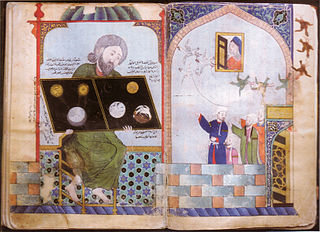
Alchemy in the medieval Islamic world refers to both traditional alchemy and early practical chemistry by Muslim scholars in the medieval Islamic world. The word alchemy was derived from the Arabic word كيمياء or kīmiyāʾ and may ultimately derive from the ancient Egyptian word kemi, meaning black.

The Mirror of Alchimy is a short alchemical manual, known in Latin as Speculum Alchemiae. Translated in 1597, it was only the second alchemical text printed in the English language. Long ascribed to Roger Bacon (1214-1294), the work is more likely the product of an anonymous author who wrote between the thirteenth and the fifteenth centuries.

Guglielmo Gratarolo or Grataroli or Guilelmus Gratarolus was an Italian doctor and alchemist.
De Alchemia is an early collection of alchemical writings first published by Johannes Petreius in Nuremberg in 1541. A second edition was published in Frankfurt in 1550 by the printer Cyriacus Jacobus.
Johann of Laz, or Johannes von Laaz, Joannes de Lasnioro, was a Bohemian alchemist during the first half of the fifteenth century.
